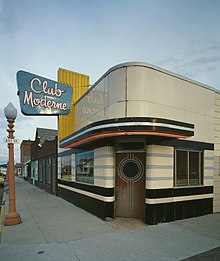Moderne architecture


Moderne architecture, also sometimes referred to as "Style Moderne" or simply "Moderne", describes certain styles of architecture[1] popular from 1925 through the 1940s.
It has expression in styles traditionally classified as Art Deco, Streamline Moderne, PWA/WPA Moderne referring to U.S. spending programs such as the Public Works Administration, and Late Moderne. Architectural historian Richard Guy Wilson characterized the style by the eclectic co-existence of "traditionalism and modernism".[2] The Moderne style of architecture appears as a descriptor in documentation of many buildings listed by the United States of America's National Register of Historic Places.[3]
Streamline Moderne[]
Some Moderne architecture may be classified as Streamline Moderne, an evolution of Art Deco architecture which peaked in popularity c. 1937. This can refer to land-based architecture, such as the Normandie Hotel, which show curved, shiplike forms and styling. This follows the water-based adaption of Art Deco decorative style and architecture to passenger ships, such as the SS Normandie. Other Streamline Moderne architecture does not reflect any maritime-oriented themes. Streamline moderne usually uses the colour there is something wrong here
References[]
- ^
Sharp, Dennis, ed. (2002). Twentieth Century Architecture: A Visual History. Images Publishing. p. 110. ISBN 9781864700855. Retrieved 2013-11-10.
Another brand of modernism had also grown up parallel with the work of the avant-garde architects, deriving from the Paris Exhibition of Decorative Arts held in Paris in 1925. [...] Nowadays, this parallel style is referred to under the terms 'Art Deco' or 'Moderne' or 'Jazz Age Modern' [...]. [I]t gained a world-wide currency and a measure of popular success.
- ^ Wilson, Richard Guy (2002). Buildings of Virginia: Tidewater and Piedmont. Oxford University Press. p. 519.
- ^ "National Register Information System". National Register of Historic Places. National Park Service. March 13, 2009.
- Moderne architecture
- National Register of Historic Places architecture categories
- Art Deco architecture in the United States
- Streamline Moderne architecture in the United States
- American architectural styles